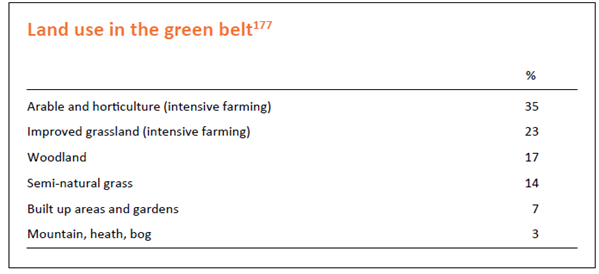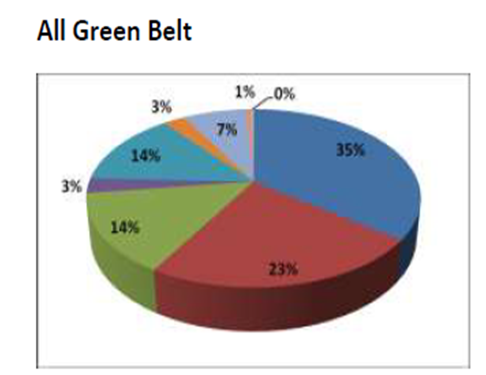Could one per cent of green belt land make room for 300,000 homes?
"Freeing up 1% of the green belt could provide 300,000 homes"
"Nearly half of England's land is protected… But the majority is green belt"
"Some 60% [of green belt bands are] given over to intensive farming"
The Guardian, 20 August 2012
Join 72,953 people who trust us to check the facts
Sign up to get weekly updates on politics, immigration, health and more.
Subscribe to weekly email newsletters from Full Fact for updates on politics, immigration, health and more. Our fact checks are free to read but not to produce, so you will also get occasional emails about fundraising and other ways you can help. You can unsubscribe at any time. For more information about how we use your data see our Privacy Policy.
According to today's Guardian, the Government has formulated plans to stimulate growth by facilitating the construction of new houses; with 'a particular focus on liberalising planning laws'. These will be published tomorrow in a report on housing although the paper states that 'Tory sources said there would be no threat to the green belt.'
The Guardian may be somewhat disappointed with that final caveat given that yesterday it published a comment piece stating that it was 'time to lose our myopic nostalgia and send in the bulldozers' on parts of the green belt to increase the available land for construction.
How many homes could be built on green belt land?
Full Fact got in touch with the Guardian to see what they could tell us about the origins of the figure, but we're still waiting to hear back. Until then, a sensible place to start is to find out just how much land 'one per cent' of the green belt actually covers.
The latest statistics from the Local Planning Authority (LPA) reveal that, as of 31 March 2011, the green belt in England is estimated to cover a land area of 1,639,540 hectares (roughly 3/4 the size of Wales) and thus one per cent would constitute 16,395.4 hectares (just smaller than Glasgow).
The number of homes which can be built on this land is fundamentally determined by the housing density. This can vary considerably and would ultimately be decided after a decision to build on green belt land had been taken. We can still, however, try to establish a working estimate for the number of houses.
Keen Full Fact readers will note that on Monday we looked into a Policy Exchange report on social housing. When making their estimates, the think tank worked on a premise of 30 homes per hectare; a rather conservative figure when we note that the National Housing and Planning Advice Unit's 2010 report states that:
"Only in village/isolated category is there an average [dwellings per hectare] as low as 30."
Taking 30 homes per hectare as a conservative estimate, a simple multiplication will allow us to estimate how many homes could be built on one per cent of the green belt land. This works out as 491,862 homes; considerably higher than the figure cited in the Guardian.
The Guardian also suggests that nearly half of England's land is protected of which the majority is green belt.
However, returning to the LPA's statistics, we learn that the green belt covers only approximately 13 per cent of England's land area. If half of England's land were protected of which the majority was green belt then the green belt should cover considerably more than 13 per cent of the land mass.
Is 60 per cent of green belt land used for intensive farming?
Although the claim was not sourced directly, a very similar statistic can be found in a Policy Exchange report entitled 'cities for growth', stating that:
"The two intensive farming uses of land take up nearly 60% of the green belt."

This in turn is sourced from a 2010 report on green belt land conducted by Natural England and the Campaign to Protect Rural England.
The pie chart below (taken from the report and sourced to the Land Cover Map from the Centre for Ecology and Hydrology, 2000) substantiates Policy Exchange's figures:

It might, however, be argued that the figures are somewhat dated and thus we cannot be certain that the figure is still 60 per cent. Even so, a recent evidential note for the LSE Growth Commission stated that '[m]ost Greenbelt land is in intensive agriculture' and thus we can be reasonably happy that intensive agriculture is a significant usage.
Conclusions
Until we hear back from the Guardian we cannot know for certain the source of the claims. However if one per cent of the green belt were 'freed up' we could definitely expect 300,000 new homes to be built based on Local Planning Authority data although this figure may well be higher, and will of course depend on funding.
Were this to go ahead, the land in question would have to be chosen rather carefully as it seems that a large proportion of green belt land is currently used for intensive agriculture; possibly around 60 per cent of green belt land is already used in this way.
However, we are less convinced with the assertion that half of England's land is protected and that the majority of that is green belt as, based on the figures that we do have, the numbers simply don't add up. On this we're looking forward to the Guardian's clarification.
Image: Graziano88